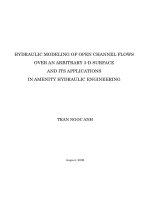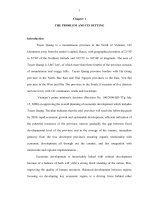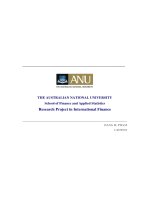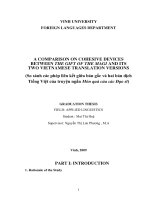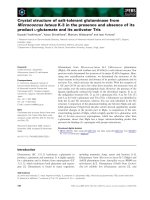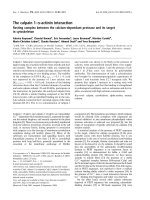How does ppp hold between australia and its trading partners.pdf
Bạn đang xem bản rút gọn của tài liệu. Xem và tải ngay bản đầy đủ của tài liệu tại đây (161.39 KB, 26 trang )
__________________________________________________________
THE AUSTRALIAN NATIONAL UNIVERSITY
School of Finance and Applied Statistics
Research Project in International Finance
_____________________________________________________________________
DANG H. PHAM
U4278723
Research Project in International Finance: 2007 Dang H. Pham
HOW DOES PPP HOLD BETWEEN
AUSTRALIA AND ITS TRADING
October the 26
th
, 2007
2
Research Project in International Finance: 2007 Dang H. Pham
Table of Contents
I. INTRODUCTION ......................................................................................... 4
II. LITERATURE REVIEW.............................................................................. 6
1. Theoretical background ......................................................................................... 6
2. Empirical evidences about PPP............................................................................. 7
3. Australian evidence................................................................................................. 9
III. METHODOLOGY .................................................................................... 11
1. Test of PPP............................................................................................................. 11
2. Effects of trade and investment on PPP.............................................................. 12
IV. DATA ...................................................................................................... 13
V. RESULTS DISCUSSION.......................................................................... 15
1. PPP with 12 countries.......................................................................................... 15
2. Effect of trading and FDI on PPP ....................................................................... 20
VI. CONCLUSION ........................................................................................ 22
VII. FUTURE RESEARCH DIRECTIONS..................................................... 23
3
Research Project in International Finance: 2007 Dang H. Pham
I. INTRODUCTION
The interrelations between three major components of the international market
(international trade, foreign exchange and capital market) are explained by the
economic theories called the international parity conditions. It is considered to be
unique to the field of International Finance (Eiteman, Stonehill and Moffett
2006:102). Deriving from the Law of one price, the absolute form of purchasing
power parity (PPP) states that if the market is frictionless the price of identical
products and services should be the same in different markets. For instance, if the
price of the product in Australian dollar is P
AUD
, then the price of the identical
product in U.S. dollar (P
USD
) should be equal to P
AUD
adjusted for exchange rate
(S
USD/AUD
), or P
AUD
x S
USD/AUD
= P
USD
. Thus, the nominal exchange rate can be
simply expressed as the ratio of the two prices (S
USD/AUD
= P
USD
/ P
AUD
). If this is not
the case, the arbitrageurs in an efficient market could make riskless profit by shipping
the goods from locations where the price is low to locations where the price is high
(Taylor and Taylor, 2004). They will trade the opportunity away and bring the
conditions back to “parity”. If the PPP holds perfectly the nominal exchange rate
adjusts to maintain a constant real exchange rate equal to 1. The relative form of PPP
involves only that the change in nominal exchange rate offsets the differential
between home and foreign price level.
While international trade plays a vital role in a PPP , obviously the market frictions
such as transportation cost, taxes, tariffs and duties, and non-tariff barriers such as
quotas and import licenses are the main causes of some deviations from PPP. In
recent years we have seen the emergence of multinational and bilateral free trade
arrangements where governments set the objectives to bust up trades by removing
trade barriers. Australia has joined WTO and signed free trade agreements with the
United States and Thailand in 2005, with Singapore in 2003 and with New Zealand
from 1993. It is now in negotiating Free Trade Agreements with other countries and
areas such as Japan, ASEAN, Malaysia, China, Chile and Gulf countries. This
research project tests the PPP between Australia and its trading partners over the
period from 1984 to 2006 and provides some insights on particular effects that the
level of bilateral trade and investment have on their PPP . Using quarterly of foreign
exchange rates and proxy for country price level (both consumer price index and
producer/whole sales price index) evidence from my sample shows that PPP holds for
4
Research Project in International Finance: 2007 Dang H. Pham
some countries while it does not hold for others. Further, the higher level of bilateral
trade significantly and positively associates with the higher level of PPP . Foreign
investment level is found to have positive impacts on PPP but not significantly.
This research is outlined as follows: Part II reviews PPP literature, in which the
subsection 1 on PPP theoretical background highlights the law of one price and the
role of international trade as crucial conditions for the existence of the parity
condition. An overall picture about extant empirical literatures on PPP including
Australian evidences is provided in subsection 2 and 3. From these reviews we
develop our arguments about the impacts of trade and investment on the PPP s
between Australia and its trading partners. Part III presents the hypothesis our
research and the methodologies, models we use to test the hypothesis in details. Part
IV describes and discuss about the data used in our research. The results of this
research are reported and discussed in Part V. Conclusion is provided in Part VI; and
Part VII proposes some direction for future research.
5
Research Project in International Finance: 2007 Dang H. Pham
II. LITERATURE REVIEW
1. Theoretical background
Economists widely believe that the PPP theory hold at least approximately because of
the possibility of the international goods market arbitrage. In the formal way, the PPP
theory states that the percentage change in the exchange rates over a given period
simply offset the difference in inflation rates in the countries concerned over the same
period. Therefore, in the relative form of PPP, according to Eiteman et al. (2006:105),
“if a country experiences a higher rate of inflation, and its exchange rate does not
change, then its goods prices will be relatively more expensive”. Eiteman et al.
(2006:105) also states that “if the spot exchange rate between two countries starts in
equilibrium, any change in differential rate of inflation between them tends to be
offset over the long run by an equal but opposite change in the exchange rate”.
Hence, the relative PPP is useful for forecasting the spot exchange (long run) rates
from the expected inflation rates in the two countries. The model is described as
follows:
t
f
t
h
fh
fh
t
S
SE
)1(
)1()(
/
0
/
π
π
+
+
=
(1.1) or (1.2)
fh
fh
S
ππ
−=Δ
/
Where: is the expected spot exchange rate at time t, is the current spot
exchange rate,
)(
/ fh
t
SE
fh
S
/
0
h
π
is the inflation rate in home country and
f
π
is the inflation rate in
foreign country. is the change in spot exchange rate in a period of time t.
fh
S
/
Δ
However, international goods markets are far less liquid than financial markets and
the frictions seem to be considerable and it is the fact that there is in existence goods
that fall outside the various range of homogeneous goods. Therefore, short-run
international arbitrage has only limited effect of leveling international goods market
prices (Rogoff, 1996).
While the traditional PPP theory holds that the real exchange rate should be constant
and equal to 1, there is another assumption of long-run deviations from PPP. Harrod
(1933), Balassa (1964) and Samuelson (1964) build their model of the equilibrium
exchange rate on the observation that rich countries tend to have higher price levels
than poor countries. This is because rich countries are relatively more productive in
the traded high-tech goods and they grow richer as a result. Income rises as a result of
6
Research Project in International Finance: 2007 Dang H. Pham
the higher productivity in tradable goods will cause price level to rise also. This effect
modeled by Harrod, Balassa and Samuelson seem to be stronger over time where data
show a strong positive relationship between income and price level. If this is true,
then the real exchange rate is not constant over time.
In general, as PPP theory is derived from the law of one price, its basic condition is
the perfect international trade of goods and services. If there is no trade, obviously no
PPP exists. The perfect trading market (without friction and transaction costs) is the
key assumption in PPP theory. In this research, an examination on PPP relation
between Australia and its different trading partners to find out the consistency and
inconsistency with the above-mentioned assumption is therefore necessary.
2. Empirical evidences about PPP
There has been a heightened level of extant literature on the validity of PPP. The
results of the PPP tests varies according to according to whether (i) price and
exchange rate levels (absolute PPP) or changes in prices and exchange rates (relative
PPP) are studied; (ii) individual commodity prices or nominal price levels are
employed; (iii) purely traded goods’ prices or non-traded as well as traded goods
prices are considered; (iv) bilateral or multilateral approach is adopted; and (v) the
short run or the long run is investigated (Rush and Husted, 1985). In the respect of
long-run or short-run validity of PPP, for example, evidence from Edler and Lehmann
(1983), Enders (1988) and Ardeni and Lubian (1991) reject long-run PPP. However,
Diebold, Husted and Rush (1991), Cheung and Lai (1993), Edison (1987), Frenkel
(1981), Branson (1981), Desai (1981), and Miller (1986) strongly support that the
PPP holds in the long run and poorly in the short-run. Cooper (1994) claims that the
main reasons for the inconclusive results are due to the difference in particular
currencies under consideration, the price indices used to measure price levels of
inflation, and the method of analysis employed.
Early empirical tests (mainly in the 1970s) find support for the long-run and
continuous PPP (Frankel, 1976 and1981). This might be partly due to the data of a
period of stable exchange rates (few years post-float after 1971- collapse of the
Bretton Woods Agreement). On the other hand, PPP deviates significantly from
equilibrium in the short-run PPP due to the sticky nominal prices (Dornbusch, 1976).
However, there is no evidence of how far do exchange rates deviate from the mean
and how fast they revert to the mean, knowing that mean reversion of exchange rates
7
Research Project in International Finance: 2007 Dang H. Pham
toward its mean is the key characteristic and necessary condition for long-run PPP to
hold (Taylor and Taylor, 2004). Studies employing unit root test of real exchange rate
(the null hypothesis is that real exchange rate follow a random walk) could not reject
the random walk (see, for example, Roll 1979);
Contemporary empirical studies of PPP are dominated by unit root tests with more
advanced techniques. Frankel ( 1986) tests the first order autocorrelation model for
the real exchange rates:
tt
eeee
εδ
+−=−
−
)
~
()
~
(
11
where
e
~
is the assumed
constant equilibrium real exchange rate and
δ
is the autocorrelation coefficient. If
δ
>1 it is an explosive process; if
δ
=1, then exchange rates follow a random walk; if
δ
<1, then there is mean reversion. The evidence from this test rejects the hypothesis
of random walk at 5% significant level. Abuaf and Jorion (1990) estimate a system of
univariate autoregressions and find in general that PPP hold in the long-run. Others
studies using longer data sets and more sophisticated models also reject the null
hypothesis of random walk (see, for example, Glenn, 1992; Dielbold, Husted
&Rush,1991; and Cheung and Lai, 1994). As evidence from many studies have
shown that exchange rates have mean reversion characteristics, it is desirable to know
how fast the exchange rates revert to the mean or in other words to what extent of
time horizon PPP holds? Reviews of Rogoff (1996) reveal that studies seem to agree
that the deviation from PPP real exchange rate has half-life of 3 to 5 years.
While some recent studies use non-linear dynamic models that allow for the
autoregressive coefficients to vary find supportive evidence of non-linear long-run
PPP. For example, Taylor, Peel and Sarno (2001) find support for non-linear mean-
reverting real exchange rates. They also find that ‘modest’ deviation of less than 5%
have half-life of less than 3 years while deviations greater than 5% have even shorter
half-life. Sarno and Valente (2006) test long-run PPP using complex non-linear
model. Their results indicate that long-run PPP does appear to hold. Further, PPP
deviations revert more quickly under floating exchange regimes. In contrast, other
latest studies on the validity of PPP even using advanced techniques still have
different results. For example, Alba and Papell (2007) examines the long-run PPP
using panel data methods to test for unit roots in the USD real exchange rates of 84
countries finds that PPP holds for European and Latin American countries but not for
Asian and African countries. Arghyrou and Gregoriou (2007) tests for long-run PPP
8
Research Project in International Finance: 2007 Dang H. Pham
using more sophisticated unit root test on G7 countries over the last 30 years. They
find that PPP does not hold in the long-run.
In general, PPP test appear to be a puzzle. The extremely high short-term volatility of
exchange rates hardly reconcile with the long-run PPP and the half-life of PPP
reversion of 3 to 5 years is too long to be caused by short-run sticky nominal prices
(Rogoff, 1996) states,. Perhaps the international goods market is not as integrated as
we think, with large trading frictions creating a ‘band of inaction’ that permits wild
fluctuation in nominal exchange rate with no effect on price levels (Rogoff, 1996;
Taylor and Taylor, 2004). Alba and Papell (2007) share the same view when they find
evidence that PPP is stronger in countries that have higher levels of trade, closer to
the US (physical distance), and countries characteristics affect PPP adherence. Based
on these finding, when testing PPP between Australia and its trading partners, this
paper hypothesizes that PPP hold better between Australia and its major trading
partners.
3. Australian evidence
In the Australia context, empirical evidence of PPP is also inclusive. For example,
Corbae and Oularis (1991) claims that PPP does not hold in long run for the
Australian dollar, as the data follow a random walk. Conversely, Olekalns and
Wilkins (1998), when re-examining the data used by Corbae and Oularis (1991), find
different results that the long-run PPP holds for Australian dollar. The research
conducted by Bhati and McCrae (2004) supports the long-run PPP when the
Australian dollar is used as the based currency in relation with the Asia-Pacific
trading partners of Australia. The exceptions include Singapore, Indonesia and New
Zealand with poor evidence of PPP. Koedijk, Schotman and Vandijk (1998: p.60)
point out that “there is substantive evidence that PPP holds for many currencies,
although not for every currency to the same extent”.
The only one thing that is clear from the evidences for Australia is that PPP varies
across its trading partners. It is our conjecture that the level of PPP depends on the
degree of trade relation between the host country and the foreign country. Hence, it is
deserved a comprehensive investigation in this research. This research project tests
PPP using the Australian dollar as a base currency with other 10 currencies selected
from countries classification by the Reserve Bank of Australia (RBA) based on trade
weights (described in Appendix 1). The test aims to find evidence which shows PPP
9
Research Project in International Finance: 2007 Dang H. Pham
holding better with higher trade weighted countries. Some abnormal cases rejected by
the test will be further discussed for appropriate reasons.
10


